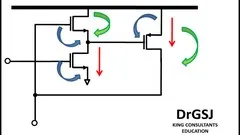
CMOS Analog IC Design - MOSFET DC BIAS and Transconductance 
This course will teach you the fundamentals of MOSFET and how to bias transistors in different regions. You will also learn about transconductance, a popular concept used in various circuits. Gain the necessary skills for in-demand jobs in sensor design, WiFi, UWB, and power management. Get a comprehesive understanding of this course which is a cost course. AZ Class provides this course data for free. Learn more certificate and details here. ▼
ADVERTISEMENT
Course Feature
![]() Cost:
Cost:
Paid
![]() Provider:
Provider:
Udemy
![]() Certificate:
Certificate:
Paid Certification
![]() Language:
Language:
English
![]() Start Date:
Start Date:
2020-06-12
Course Overview
❗The content presented here is sourced directly from Udemy platform. For comprehensive course details, including enrollment information, simply click on the 'Go to class' link on our website.
Updated in [October 18th, 2023]
What does this course tell? (Please note that the following overview content is from the original platform) "Analog circuit design is like chess - just because you know how the pieces move doesn't mean you know how to play the game" - Patrick LaheyIn this course you will learn about the fundamentals of MOSFET the ways to bias the transistors in triode&linear cut-off and saturation regions Later in the course you will learn about transconductance Gm which is currently being used popularly in sensor read out circuits broadband circuits and in high speed design The Constant-Gm circuit is extremely popular in low power circuit designs This course is a prerequisite for the course "CMOS Analog Circuit Design - Amplifiers with Solved Examples" and "Circuit Design for High Speed Serial Links" Consequently were seeing analog job requisitions in several key areas including Sensor Design and Sensor interfaces WiFi (wireless LANs and Internet access) ultra wide band technology (UWB) and power management Demand for designers with expertise in high-speed data conversion seems to be high across a variety of industries We considered the value of this course from many aspects, and finally summarized it for you from two aspects: skills and knowledge, and the people who benefit from it: (Please note that our content is optimized through artificial intelligence tools and carefully reviewed by our editorial staff.) What skills and knowledge will you acquire during this course? During this course, the learner will acquire the following skills and knowledge: 1. Understanding of the fundamentals of MOSFET: The learner will gain a comprehensive understanding of the working principles and characteristics of MOSFETs, which are essential components in analog integrated circuit (IC) design. 2. Biasing techniques for transistors: The course will cover various methods to bias MOSFETs in different operating regions, including triode, linear cut-off, and saturation. This knowledge is crucial for designing analog circuits that operate within desired voltage and current ranges. 3. Transconductance (Gm): The learner will learn about transconductance, which is a measure of the relationship between the input voltage and the output current in a transistor. Gm is widely used in sensor readout circuits, broadband circuits, and high-speed design. 4. Constant-Gm circuit design: The course will introduce the concept of the Constant-Gm circuit, which is highly popular in low-power circuit designs. The learner will gain the skills to design circuits that maintain a constant transconductance, enabling efficient and reliable operation. 5. Prerequisite for advanced courses: Successful completion of this course is a prerequisite for enrolling in courses such as "CMOS Analog Circuit Design - Amplifiers with Solved Examples" and "Circuit Design for High-Speed Serial Links." These advanced courses delve deeper into analog IC design and its applications. 6. Job opportunities: The course content aligns with the current demand for analog designers in various industries. Job requisitions are particularly high in areas such as sensor design, sensor interfaces, WiFi technology, ultra-wideband technology, and power management. Additionally, expertise in high-speed data conversion is sought after across multiple industries. Overall, this course equips the learner with the necessary skills and knowledge to design analog circuits using MOSFETs, understand biasing techniques, and apply transconductance concepts in practical circuit design. Who will benefit from this course? This course on CMOS Analog IC Design - MOSFET DC BIAS and Transconductance will benefit individuals interested in or working in the field of analog circuit design. Specifically, it will be beneficial for: 1. Analog Circuit Designers: This course will provide a solid foundation in MOSFET fundamentals and biasing techniques, which are essential for designing analog circuits. It will enhance their understanding of transistor behavior in different regions and enable them to design circuits with improved performance. 2. Sensor Designers: Transconductance (Gm) is widely used in sensor readout circuits. This course will cover the principles of Gm and its application in sensor interfaces. Sensor designers will gain valuable knowledge to design efficient and accurate sensor circuits. 3. Broadband Circuit Designers: Gm is also utilized in broadband circuits, which are essential for high-speed data transmission. This course will equip broadband circuit designers with the necessary skills to optimize circuit performance using Gm-based techniques. 4. High-Speed Designers: The Constant-Gm circuit, which is covered in this course, is popular in low-power circuit designs. High-speed designers will benefit from learning about this circuit as it can be used to achieve high-speed operation while minimizing power consumption. 5. Professionals in Sensor Interfaces: With the increasing demand for sensor interfaces in various industries, professionals working in this field will benefit from this course. It will provide them with the knowledge and skills required to design efficient and reliable sensor interfaces. 6. Professionals in WiFi and UWB Technology: WiFi and ultra-wideband (UWB) technologies require high-speed data conversion and efficient circuit design. This course will enhance the expertise of professionals working in these areas, enabling them to design circuits that meet the requirements of these technologies. 7. Power Management Professionals: Power management is a critical aspect of analog circuit design. This course will provide insights into MOSFET biasing techniques, which are essential for efficient power management. Professionals in this field will gain valuable knowledge to optimize power consumption in their designs. Overall, this course will benefit individuals interested in pursuing careers in analog circuit design or those already working in related fields. It will equip them with the necessary knowledge and skills to design efficient and high-performance circuits in various applications.
Course Syllabus
Introduction
MOSFET Characteristics
Transconductance and Channel Resistance
Secondary Effects of Device Operation
MOSFET- Amplifier and Small signal analysis
Course Provider

Provider Udemy's Stats at AZClass
Discussion and Reviews
0.0 (Based on 0 reviews)
Explore Similar Online Courses

Analog Engineering Interview Preparation (Analog CMOS IC)

Analog Circuits From Scratch

Python for Informatics: Exploring Information

Social Network Analysis

Introduction to Systematic Review and Meta-Analysis

The Analytics Edge

DCO042 - Python For Informatics

Causal Diagrams: Draw Your Assumptions Before Your Conclusions

Whole genome sequencing of bacterial genomes - tools and applications

How to Design Your Own Chip And How to Build it For Free (It Is Possible) - with Matt Venn

HWN - "20-year Analog IC Designer" vs Our Team (Interview Question)


Start your review of CMOS Analog IC Design - MOSFET DC BIAS and Transconductance